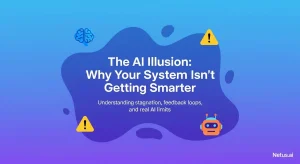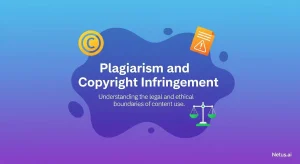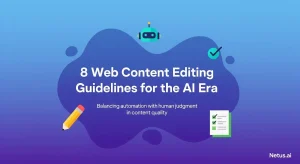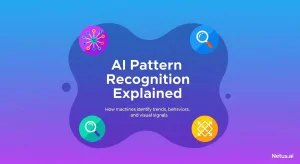Artificial Intelligence: A Big Deal for Plagiarism Checker Tools in 2024
Ashley Merit
Content writer and editor for Netus.AI
Table of Contents
Artificial Intelligence. In today’s digital age, technology plays a crucial role in enhancing efficiency and productivity. As businesses race against time, automation has become increasingly essential for staying competitive. Artificial intelligence (AI), the most cutting-edge technology, has emerged as a game-changer in automating tasks, leaving conventional methods like macros far behind.
Plagiarism detection is one area where AI has made significant strides. Its adoption in anti-plagiarism software has revolutionized online learning and the traditional classroom environment, ensuring authentic content production and academic integrity.
Key Takeaways
- AI is transforming automation in various fields, including plagiarism detection software.
- Employing AI in plagiarism checkers has strengthened academic integrity in both online learning and classroom settings.
- The technology’s widespread use reflects the fundamental importance of innovation in keeping pace with the digital age.
Artificial Intelligence – The Next Big Thing
Artificial Intelligence (AI) is gaining immense popularity as it automates tasks that typically require human intelligence. Unlike traditional software, AI systems can learn tasks independently, without explicit programming.
One essential aspect of AI is machine learning, which teaches AI systems how to perform tasks by analyzing data. Three main types of machine learning algorithms are employed by developers:
- Supervised Learning Algorithm: In this approach, human assistance is provided through additional information or data, enabling the AI system to learn and function correctly. It involves splitting the data into a labeled set and a training set. The labeled set helps AI identify patterns, while the training set fine-tunes the system.
- Unsupervised Learning Algorithm: This type of learning does not involve human intervention. AI trains itself using the given dataset, striving for higher accuracy in its outputs. Since there is no labeled dataset, the AI must find patterns within the data to make accurate predictions.
- Reinforcement Algorithm: Using a reward and punishment system, this algorithm fosters learning through experience and interaction with various elements in the environment. AI enhances its performance with each iteration, regardless of whether predictions are right or wrong.
With technological advancements, AI has evolved, leading to the development of generative AI and other sophisticated tools. GPT-3, a state-of-the-art language model, exemplifies the increasing capabilities of AI systems. We can expect AI to continue transforming various sectors, including plagiarism detection and multimodal systems that utilize images, sounds, and videos alongside text.
As AI pushes the boundaries of innovation, smaller language models and open-source advancements are projected to be significant trends in the coming years [(IBM Blog]. Alongside these developments, concerns related to GPU shortages, cloud costs, and data pipelines will need to be addressed.
In conclusion, AI is undeniably the next big thing in technology, poised to revolutionize various industries with its applications, algorithms, and predictive capabilities. As AI continues to grow, its influence and potential for innovation will only increase.
How Does Implementing AI in Plagiarism Checker Help?
Plagiarism has become a growing concern for content creators worldwide. Traditional plagiarism detectors have difficulty identifying certain cheating tactics, such as using unrecognizable foreign characters or symbols. To address this issue, developers have begun integrating AI technology into their plagiarism scanners, resulting in more accurate and efficient detection.
AI-powered plagiarism checkers offer several benefits:
- Better accuracy: These checkers can identify not only direct plagiarism but also subtle similarities in meaning and sentence structure, improving overall accuracy.
- Foreign character detection: AI systems can recognize the use of foreign characters that may not be detected by the human eye, making it harder for cheaters to bypass plagiarism checks.
- Efficiency: The incorporation of AI allows the tools to process and analyze large amounts of data more quickly, reducing the workload on teachers and other higher education professionals.
- Comprehensive plagiarism reports: AI detectors generate detailed plagiarism reports, providing valuable guidance and ensuring adherence to policy.
The implementation of AI in plagiarism detection not only enhances the authenticity and authorship verification but also contributes to maintaining academic integrity. Universities and educators can rely on these advanced tools to uphold honesty and prevent cheating in the world of higher education, ensuring a more level playing field.
Various Features Offered by Plagiarism Checker Tools
Plagiarism checker tools powered by artificial intelligence offer numerous helpful features for checking content across different platforms. Here are some of the key features provided by these tools:
- URL Search: A convenient feature that allows users to search for duplicate content by simply entering the website URL, saving time and effort previously spent on pasting content or uploading files.
- Text Comparison Feature: Especially relevant for analyzing multiple academic papers or articles, this feature ensures no content is copied from one submission to another. It streamlines the process, eliminating the need to constantly swap out content for testing.
- Code Checker: Plagiarism is not limited to written content; it can also be found in programming code. Code scanners detect copied code in various programming languages, ensuring originality and integrity in software development.
- Ignore Feature: This customizable option enables users to specify certain words, sentences, or symbols to be ignored during the plagiarism checking process. Consequently, these items will not be flagged or appear in the final report.
These tools continue to evolve and improve as researchers and computer scientists delve deeper into AI applications, predicting a significant role for artificial intelligence in the future of plagiarism detection. With their advanced features, plagiarism checker tools have become essential resources for content creators to ensure original and high-quality human and AI-generated writing.
Frequently Asked Questions
How does AI enhance the accuracy in detecting duplicated content?
AI plagiarism checkers learn from a vast amount of data, allowing them to recognize complex patterns and analyze large chunks of text. By comparing input text to numerous sources, AI tools can detect rephrased, synonymized, and altered content more accurately than traditional methods. This helps to improve the effectiveness of identifying copied content.
What advantages do AI-driven plagiarism detectors offer over conventional methods?
AI-powered plagiarism detectors provide several benefits over traditional methods:
- Increased accuracy: AI tools can identify more subtle forms of plagiarism, such as paraphrasing and rewording.
- Faster speeds: AI algorithms process text more quickly, making them suitable for analyzing large amounts of content.
- Continuous improvement: As AI systems learn from new data, their performance improves over time, offering more reliable results.
- Customizable detection: AI tools can be tailored to specific needs, such as academic research or content creation, providing more targeted and relevant results.
Can AI-based plagiarism checkers efficiently analyze larger texts (e.g., 15,000 words)?
Yes, AI-driven plagiarism checkers are designed to handle large volumes of text efficiently. They can quickly analyze lengthy documents, such as articles, research papers, or dissertations, with consistent accuracy and speed. This efficiency makes them a valuable tool for both students and professionals who require thorough plagiarism checking.
Is there a significant difference between premium and free AI plagiarism detection tools?
Premium AI plagiarism detection tools generally offer more features and higher accuracy than their free counterparts. While free tools can provide valuable insights, premium tools often deliver more comprehensive reports, access to broader databases, and additional customization options. The choice between free and premium tools depends on individual needs and budget constraints.
What characteristics make an AI plagiarism checker comparable to Turnitin in terms of efficiency?
AI plagiarism checkers similar to Turnitin share several features that contribute to their efficiency:
- Extensive databases: They access vast collections of academic and online resources to provide in-depth comparisons.
- Advanced algorithms: These tools use machine learning and natural language processing to detect even subtle instances of plagiarism.
- Detailed reports: Efficient AI plagiarism checkers offer comprehensive reports with similarity scores, matched sources, and highlighted instances of potential plagiarism.
- User-friendly interfaces: An intuitive interface simplifies the process of uploading documents, customizing settings, and understanding results.
How can AI be applied to reinforce academic integrity and prevent plagiarism?
AI can be utilized in various ways to strengthen academic integrity and reduce plagiarism:
- Implementing advanced plagiarism detection tools: Using AI-driven plagiarism checkers helps identify instances of plagiarism more effectively and accurately than conventional methods.
- Educating students: AI-powered tools can act as learning aids, teaching students proper citation practices, paraphrasing techniques, and ways to avoid plagiarism.
- Automating content analysis: AI algorithms can be employed to monitor and evaluate the originality of content published by educational institutions, ensuring academic integrity and higher quality standards.

The shortcomings of content generated by AI | NetusAI
Discover why fast, high-volume AI content often fails to deliver real results. Learn about the crucial missing feedback loop and how implementing performance tracking can transform your AI content strategy.

The illusion of AI: Your system's intelligence gap | NetusAI
Stop wasting marketing spend! Most AI tools don’t learn from results, causing content stagnation and low engagement. Discover why your generative AI isn’t getting smarter and what system actually learns and optimizes content.

Plagiarism and copyright infringement | NetusAI
Learn the distinct differences between plagiarism and copyright infringement. Understand the ethical and legal implications and get practical strategies for avoiding both academic and creative work with NetusAI.

Tips and strategies for mobile content marketing | NetusAI
Optimized for mobile-first indexing, learn 5 essential strategies to capture attention, enhance engagement and drive leads and sales with your mobile content marketing.

Web content editing guidelines for the AI era | NetusAI
Review web content editing guidelines for the AI era. Learn how to edit AI-generated content, ensure authenticity and optimize for SEO and readability.

Explaining AI pattern recognition | NetusAI
AI pattern recognition enables machines to identify trends for diverse applications, from detecting plagiarism to fraud. Discover its processes, models and real-world benefits.
